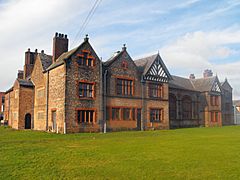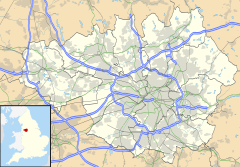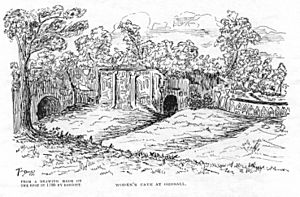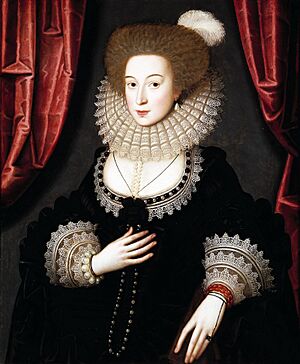Ordsall, Greater Manchester facts for kids
Quick facts for kids Ordsall |
|
|---|---|
 Ordsall Hall |
|
| Population | 14,194 (2011.ward) |
| OS grid reference | SJ815975 |
| Metropolitan borough | |
| Metropolitan county | |
| Region | |
| Country | England |
| Sovereign state | United Kingdom |
| Post town | SALFORD |
| Postcode district | M5 |
| Dialling code | 0161 |
| Police | Greater Manchester |
| Fire | Greater Manchester |
| Ambulance | North West |
| EU Parliament | North West England |
| UK Parliament |
|
Ordsall is a part of Salford, a city in Greater Manchester, England. In 2011, about 14,194 people lived there. It is located south of the A57 road, near the River Irwell. This river forms the main border with the city of Manchester.
Ordsall is also close to Salford Quays and the Manchester Ship Canal. Historically, Ordsall was part of Lancashire. It is famous as the birthplace of the bush roller chain. Ordsall is also home to the historic building, Ordsall Hall.
Contents
History of Ordsall
The name Ordsall comes from Old English words. Ord was a personal name, and halh meant a corner or a nook. This description fits Ordsall well. Its southern border is a large bend in the River Irwell. This bend later became the site of docks for the Manchester Ship Canal.
Ordsall was first mentioned in records in 1177. At that time, it paid a tax called an "aid." A geologist named Samuel Hibbert-Ware had a different idea about the name. He thought ord meant "very old" and hal meant "den." So, Ordsall could mean "very old den." He believed this because of a cave in the area called Woden's Den.
Woden's Den Cave
Before the River Irwell was made deeper for boats, there was an old paved crossing at Ordsall. It was known as Woden's Ford. Nearby, on a lane leading to Ordsall Hall, was a cave called Woden's Den. People in the 1800s were very interested in this cave.
However, the landowner destroyed it early in the century because people kept trespassing. No part of the cave remains today. Thomas Barret sketched the cave around 1780. He thought that travelers might have made offerings to Odin there. Odin was believed to protect travelers. This was because the river often flooded at this spot.
Barret also suggested that monks from Lenton Priory might have used the cave. They may have turned it into a Christian hermitage. They could have guided people across Woden's Ford and through the nearby marshes. This might have replaced older pagan practices.
Ordsall's Modern Changes
By the 1990s, Ordsall was one of the most challenging areas in Greater Manchester. In 1994, a newspaper reported that many people were unemployed.
Since 2007, the area has been undergoing a big project to improve it. This project is a partnership between Salford City Council and a property developer. The plan, called "Heart of Ordsall," started in 2005. It aims to make many improvements to the area. This includes better environments and new buildings.
The community is very involved in these changes. A new primary school and children's center have already been built. This school can teach 315 students. The children's center offers education, health, and social care for the community. Local children even helped design a special street sweeper. It cleans the area three times a week.
The project plans to build between 800 and 1,000 new homes. These homes are for local families and people buying their first home. A new community center will serve all of Ordsall. There are also plans to improve Ordsall Park and other play areas.
The area will also become more open for shoppers. The old Radclyffe School site is planned to become a new shopping center. New paths for walking and cycling will be added. The area will be made safer. Access to nearby Metrolink stations will also be improved. This will make it easier to reach Salford Quays and Manchester city centre.
Over £40 million has already been invested privately in Ordsall. This has created hundreds of homes. These homes are for first-time buyers and local people. Examples include Gresham Mill on the River Irwell and Radclyffe Mews. Quay 5, a £24 million project with 231 flats, sold out very quickly.
Transportation in Ordsall
The Ordsall Chord railway line started working on December 10, 2017. This short railway line connects Manchester Piccadilly and Manchester Oxford Road to Manchester Victoria. It helps more trains run and makes journeys faster through Manchester.
This line allows trains from places like Newcastle and Leeds to go directly to Manchester Airport. They no longer have to change direction at Manchester Piccadilly.
Ordsall's Economy and Growth
Ordsall is located between Manchester city centre and Salford Quays. This location has led to a big growth in the area. House prices have gone up a lot in the last five years. Ordsall is now part of important plans like the Irwell City Park scheme.
A study in 2007 showed that Ordsall had become one of the UK's top places for property. It was ranked 17th out of 35 areas. The study looked at homes bought by young, successful professionals.
Famous Landmarks in Ordsall
Ordsall Hall
Ordsall Hall is a Tudor mansion. For over 300 years, it was the home of the Radclyffe family. In more recent times, it has been used as a working men's club and a school.
Like many old buildings, Ordsall Hall is said to be haunted. People talk about "the White Lady." She is said to have jumped from the balcony overlooking the Great Hall. A TV show called Most Haunted filmed an episode there in 2002.
Salford Lads' Club
Ordsall is home to Salford Lads Club. This club is shown on the inside cover of the album The Queen Is Dead. This album was made by the pop band the Smiths. The club is on the corner of St Ignatius Walk and Coronation Street.
St Clement's Church
St Clement's Church is the main Anglican church in Ordsall. The church opened in 1877. It is now a Grade II listed building, meaning it is a very important historic building.
St Joseph's Church
St Joseph's Roman Catholic Church is one of the few buildings that survived the Ordsall slum clearances. The church was designed by W. Randolph. It cost £5,000 to build, which would be a lot more money today. It opened on April 20, 1902.
The building was badly damaged during the Manchester Blitz in Christmas 1940. The inside of the church has been rebuilt and updated since then.
Education in Ordsall
St. Joseph's RC Primary School was rated as "outstanding" in 2007. It was also one of the top 100 performing schools in the UK. New schools have been built in the area, including Primrose Hill Primary. There are also plans for a new academy linked to MediaCityUK at Salford Quays.
Famous People from Ordsall
- Mark Addy (1838–1890) was a brave man who saved lives. He received the Albert Medal (lifesaving) and other awards. He was a landlord of a local inn until he passed away.
- Joe Gladwin, an actor, grew up in Ordsall. He was best known for playing Wally Batty in the TV show Last of the Summer Wine.
- Alistair Cooke, a journalist and presenter, was born in Ordsall. His family later moved to Blackpool because of his health.
- Eddie Colman was a footballer for Manchester United. He was one of the "Busby Babes" and died in the Munich air disaster in 1958 at age 21. He was born in Archie Street, Ordsall.
- Alan Clarke and Graham Nash from the pop group The Hollies grew up and went to school in Ordsall.
- Nigel Pivaro, an actor from Coronation Street and a journalist, lived in Ordsall for many years. He has written about the area.
- Tim Burgess from the band The Charlatans lived in Oldfield Road in the 1990s.
- Billy Garton, a footballer for Manchester United, lived in Ordsall while playing for the club.
- Peter Hook from the pop group New Order has many family members from Ordsall. He was also a member of Salford Lads Club.
See also
 In Spanish: Ordsall para niños
In Spanish: Ordsall para niños





